Welcome back to our foray into Laundry Day. We're going to continue with the PLAN phase of our process improvement.
As a recap, let's take another look at the Future State of our Laundry Day process..
We'll begin our next step by looking at the most labor intensive steps and see where we can reduce unnecessary movements.
A WORD ABOUT FOLDING
Now some would say that folding is the most labor intensive step and ask if it is really necessary. That depends on your own personal needs. If you have an exquisite, large walk-in closet and space to hang everything, then very little folding is required. Or, if you are one of those people who are content to pull their clean clothes out of a laundry basket or off the floor every morning, than folding is an unnecessary step. But process improvement is really about maintaining a high standard of customer satisfaction and in my house, clothes get folded.
UNNECESSARY MOVEMENTS AND SORTING
Ideally, each article of clothing would only be handled once. That however really isn't possible. It would require a single machine to wash and dry (which do exist) for each different setting requirements (which would be cost prohibitive) and be located where people remove their clothing (not feasible in my house). Efficiency in the real world will always have practical limits.
At the beginning of the process clothes are removed and placed into a single hamper. They are then removed from the hamper to be sorted into wash loads. But what if we had a hamper that divided the one big pile of clothes into their wash loads. Something like this:
Using a divided hamper takes no more time than using a single hamper and eliminates the first sort (into light and dark loads). The hurdle here is that people would need to know which bin to put their clothes in. An easy way to do this is with a visual card pined to the front of each bag to show what kind of clothes go in each bin. Here's an example:
The clothing images came from the gapcanada.ca website, but you could photograph your own clothes too.
If we select groupings for the divided hamper by wash and dry settings, loads can move in bulk through the process. The second sort before the drying stage is eliminated and we no longer have to sift through wet, twisted up clothes to find the one thing that can't go in the dryer.
This will also help with delegation of the laundry day process. Easy instructions, "Dry on Medium", can be given rather than "The beige shirt with 5 buttons, the pink sweater and the black pants need to be hung up". Even better, the instructions are already printed on the card on the front of the bag!
LOAD PRIORITIZATION
Okay, so now you have 2 or more loads of laundry that need to get done in succession. You want to minimize the total time to wash and dry all the loads by minimizing the time the washer and dryer are not in use. This becomes particularly useful if you are at a laundry mat, in a hurry and only have use of one machine.
Break open your Operations Management textbook Boys and Girls, it's time to take a look at Johnson's Rule for Scheduling n jobs on 2 machines. Or look at the Wikipedia page which does a pretty good job of explaining it.
To illustrate Johnson's Rule, let's see how this works for my laundry:
STEP 1:
List out all the jobs with their process times for both machines.
STEP 2:
Find the job with the shortest process time on either machine. In this case, the Hang Dry load that doesn't use the dryer. If the shortest time is on Machine 2 (the Dryer) do that job last, if it is on Machine 1 (the Washer) do it first. Break ties any way you like, it won't matter.
STEP 3:
Repeat Step 2 until all the jobs have been prioritized.
So the final order for my 4 loads of laundry looks like this:
NEXT STEPS
Okay, so now we have the plan. Sort the laundry when it comes off rather than gathering it all together, separate loads based on wash and dry settings and prioritize loads to minimize total process time.
The next steps here are DO and CHECK. In this case, I'll implement these solutions and see how it improves my laundry day process. Check back in a couple weeks for the results.
Why don't you give it a try to and let me know how it works for you! Happy Washing.








I had a light bulb moment today. The ratio of size of my washing machine vs the amount of clothes I have makes more than two loads of laundry impractical, especially since there isn't a delicate cycle, and I've been trying to figure out how to separate out the things that needed to be hung or laid flat to dry. Finally, I figured it out. Since they are generally delicates and go into mesh laundry bags anyway, I simply separate out the things that need to be hung up in one bag, lain flat in another, and the tumble dry in the third, along with the rest of the load.
ReplyDelete